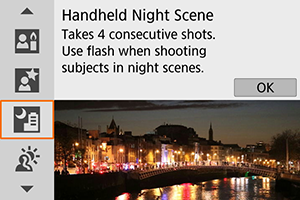Handheld Night Scene Mode
The [] (Handheld Night Scene) mode enables you to shoot night scenes even in handheld shooting. In this shooting mode, four shots are taken consecutively for each picture, and the resulting image with reduced camera shake is recorded.

Shooting tips
-
Hold the camera steady.
Keep your elbows close to your body to hold the camera steady (). In this mode, four shots are aligned and merged into a single image, but if there is significant misalignment in any of the four shots due to camera shake, they may not align properly in the final image.
-
For portraits, use flash.
If your shots will include people, use the built-in flash or a Speedlite. For nicer portraits, flash is used for the first shot. Tell the subject not to move until all four consecutive shots are taken.
Caution
- Compared to other shooting modes, the image area will be smaller.
- RAW image quality cannot be set.
- When you shoot a night scene with Live View shooting, achieving focus with AF may be difficult if point sources of light are found in the AF point. In this case, set the lens's focus mode switch to
and focus manually.
- The Live View image displayed will not look exactly the same as the actual captured image.
- If you use a flash and the subject is close, overexposure may result.
- If you use a flash for a night scene with limited lighting, the shots may not align correctly, which may result in a blurry picture.
- If you use a flash with a human subject close to the background that is also illuminated by the flash, the shots may not align correctly. This may result in a blurry picture. Unnatural shadows and unsuitable colors may also appear.
- Flash coverage angle with a Speedlite:
- When using a Speedlite with automatic flash coverage setting, the zoom position will be fixed to the wide (wide-angle) end regardless of the lens's zoom position.
- When using a Speedlite requiring manual flash coverage setting, set the flash head to the normal position.
- If you shoot a moving subject, the subject's movement may leave afterimages or the surrounding area of the subject may become dark.
- The image alignment may not function properly with repetitive patterns (lattice, stripes, etc.), flat or single-tone images, or images significantly misaligned due to camera shake.
- It takes some time to record images to the card since they are merged after shooting. “buSY” and “BUSY” appear in the viewfinder and on the screen, respectively, as images are processed, and shooting is not possible until processing is finished.
